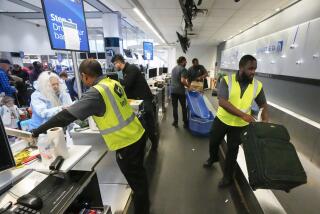Regulations Should Help Disabled : Airlines: New rules due to go into effect next month are expected to help keep handicapped travelers from being victims of discrimination.
- Share via
Disabled travelers should have an easier time flying after a batch of new rules issued by the Department of Transportation go into effect June 4.
“These new rules, if really enforced by the DOT, will bring about fairer treatment of people with disabilities,” said Yvonne Nau, a travel agent and spokeswoman for TIDE, the Los Angeles-based Travel Industry & Disabled Exchange. “But a lot more training is needed of carrier personnel.”
A key provision is that the airlines can’t refuse to fly a person because of a physical or mental disability, unless transporting that passenger would be “(detrimental) to the safety of a flight.”
While it’s still up to the airline to make this determination, it has to provide the passenger with a written explanation within 10 days if it denies boarding.
At the present time, airlines can’t limit the number of handicapped passengers on flights, and disabled passengers don’t have to give the carrier 48 hours’ notice of their condition unless special facilities are needed such as a hook-up for a respirator, an incubator or a stretcher.
Advance notice is still required if the airline needs to provide a wheelchair on a plane that lacks an accessible lavatory, or packing space to store hazardous materials for a wheelchair battery.
Wheelchairs now have priority over carry-on baggage in cabin storage areas of planes with 100 or more seats.
“This is a good rule,” Nau said. “In the past, wheelchairs seemed to automatically go into the cargo hold, which meant waiting for them to be brought forward, and that was usually long after all the other passengers had gotten off.
“Most planes don’t have accessible lavatories, so waiting to get off is an additional inconvenience, and sometimes a very serious one.”
Airlines can’t require disabled passengers to fly with attendants unless they decide that the passengers need such assistance, such as with sight or hearing disabilities that would prevent communication on safety and emergencies.
If the carrier and the handicapped passenger disagree on this issue, the airline can require an attendant, but must allow that person to fly at no charge.
Moreover, if the flight is overbooked and there’s no seat for such an attendant, the handicapped passenger is then eligible for denied-boarding compensation.
“This is a gray area,” Nau said. “This kind of decision really has to be reached before the disabled passenger reaches the airport. I don’t know how it will work out. Airlines might be more prone to let disabled passengers fly without attendants rather than give away a free seat.”
Nau still applauded the rule, however.
“In the past, a disabled passenger might indicate he didn’t plan to eat on the flight and therefore didn’t require an attendant,” she said. “But some airlines would still insist that this passenger needed an attendant. The rule is designed to stop this sort of arbitrary behavior on the part of airlines.”
In addition, airlines can’t require that disabled passengers accept any special services, such as preboarding, that the passengers haven’t requested.
Airlines also can’t discriminate against handicapped passengers on where they sit, except where exit rows are involved. In these situations, the airlines have the right to allow only passengers who are capable of opening exit doors and windows to occupy these seats. Disabled groups are still challenging this rule.
“There are always wrinkles the carriers can use,” Nau said. “In one case that happened in late April, an airline wouldn’t let a mother and daughter, both in wheelchairs, sit together although their boarding passes had them sitting together.
“The daughter was forced to move, after already being seated, and put in another row on the basis that two passengers in wheelchairs would be easier to handle in an emergency if they weren’t in the same row. They complained to the station manager, who backed up the flight purser.”
New wide-bodied jets entering service in two years will have to be equipped with special lavatories for disabled passengers, and carry narrow wheelchairs that can move in the aisles.
These special wheelchairs will have to be available on 48 hours’ notice on all other planes with 60 or more seats.
New aircraft with 30 or more seats that enter service two years from now will need to have movable aisle-seat armrests on at least half the rows. Planes already in service will need to be re-equipped with movable armrests in half the aisle rows if they receive major overhauls or renovations.
“This is also an area where airline personnel need more training,” Nau said. “Some planes already have a number of seats with movable armrests, but neither the reservations or flight crews know where they are.
“For example, on a recent flight, I saw a passenger in a wheelchair climb over an aisle row armrest to be seated. Only after being seated was it discovered that this aisle-row seat had a movable armrest.”
Predictably, airlines have protested the new regulations, arguing that they are not all necessary and, in fact, create economic hardships.
One figure that has been bandied about by the Air Transport Assn., which represents the major airlines, is that the total cost of implementing the new rules will cost the carriers close to several billion dollars over the next two decades.
The Department of Transportation, however, indicated that the cost to the airlines would be about $400 million over the next 20 years.
Regardless of the cost to carriers, consumers can expect fares to reflect these airline expenditures.
One key to the new rules, which expand the prohibitions against discrimination involving disabled passengers in the 1986 Air Carrier Access Act, is the additional training that airlines have to provide for their personnel. This training is expected to create more of a standardized method of treating disabled passengers.
“The amount of training the airlines give may differ in depth and interpretation,” Nau said. “So it’s still conceivable that check-in and boarding agents of the same airline at different airports can reach different conclusions about the degree of disability of passengers.
“But the potential for these sorts of situations should be diminished by the more stringent set of guidelines.”
Passenger problems should be brought to the attention of the DOT. You may not get personal satisfaction, but the complaints add up and may lead to new rules and tighter interpretations of existing regulations.
“Passengers who feel that the rules have not been followed can contact the Department of Transportation and we’ll look into it,” said Bill Moseley, a DOT spokesman. “Airlines can be fined.”
More to Read
Sign up for The Wild
We’ll help you find the best places to hike, bike and run, as well as the perfect silent spots for meditation and yoga.
You may occasionally receive promotional content from the Los Angeles Times.






